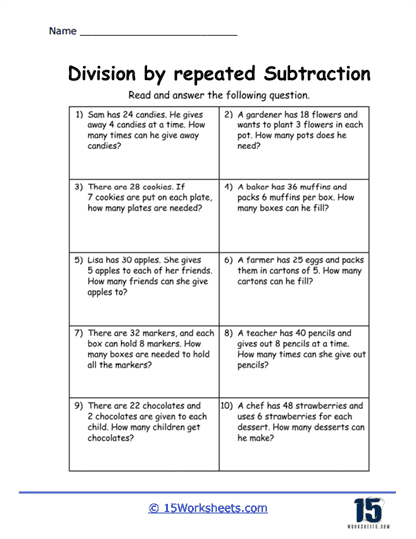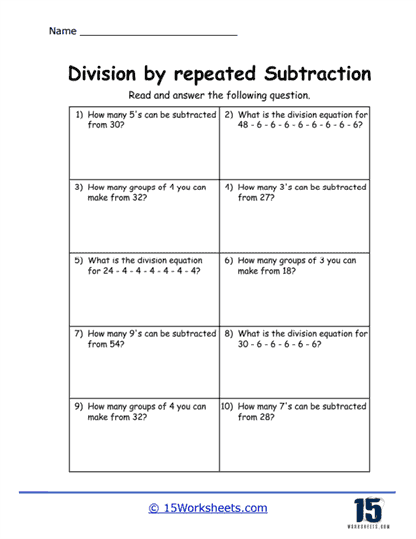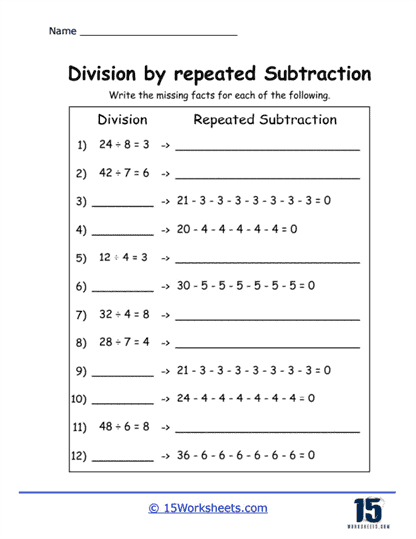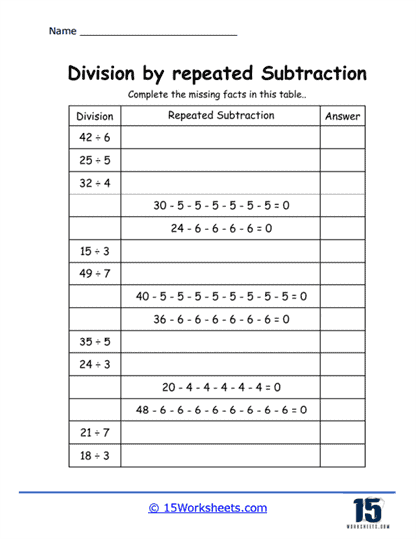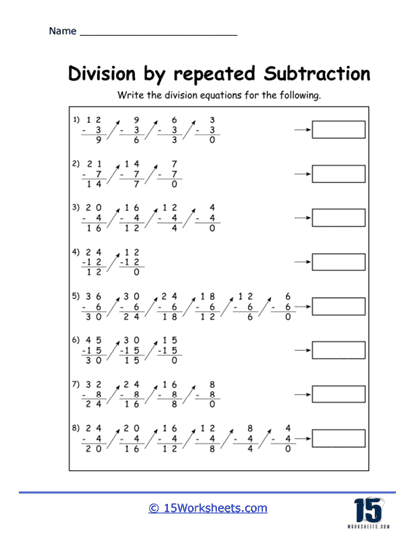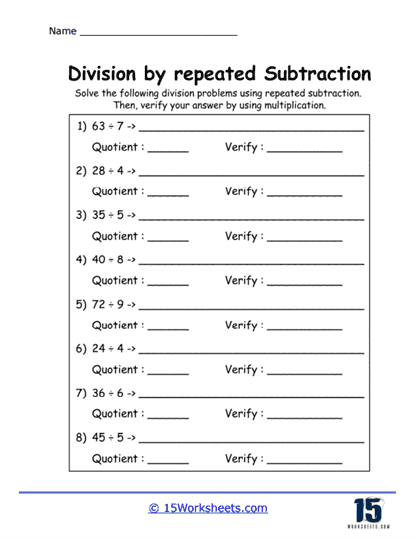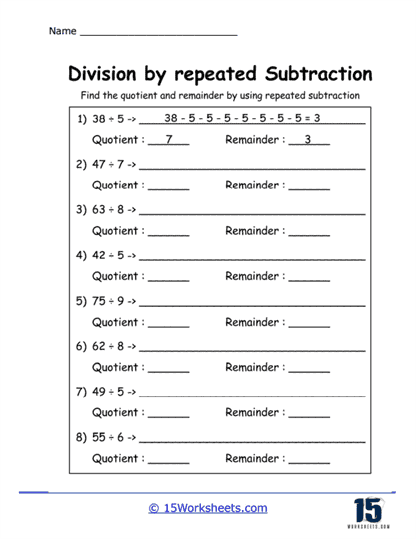Division as Repeated Subtraction Worksheets
About These 15 Worksheets
Division as repeated subtraction is a foundational concept in mathematics that helps students understand division by breaking it down into a simpler, more relatable process. Worksheets that focus on this concept are essential for young learners, typically in early elementary grades, as they begin to grasp the mechanics of division. These worksheets are designed to build a solid understanding of how division works by repeatedly subtracting the divisor from the dividend until what remains is less than the divisor. By reinforcing this method, students develop a concrete sense of division as a form of subtraction, which is crucial for their future success in more advanced math.
These worksheets introduce students to the concept of division through a process they are already familiar with: subtraction. Rather than diving straight into the abstract notion of division, these worksheets guide students to subtract the divisor from the dividend multiple times, step by step, until they can no longer subtract without going negative. The number of times they subtract represents the quotient, and whatever remains represents the remainder.
These worksheets start with simple problems to ease students into the concept and gradually increase in difficulty as their understanding deepens. The problems might involve both small and larger numbers to ensure students gain confidence with a range of division scenarios. The goal of these worksheets is not only to teach division but also to enhance students’ subtraction skills, which are integral to their overall mathematical development.
Types of Problems and Skills Taught
1. Basic Repeated Subtraction Problems
The most common type of problem on these worksheets involves straightforward division where the dividend is easily divisible by the divisor, resulting in no remainder. For example, a problem might present students with 12 divided by 3. The worksheet would guide them to subtract 3 from 12 repeatedly (12 – 3 = 9, 9 – 3 = 6, 6 – 3 = 3, 3 – 3 = 0), counting the number of subtractions to determine the quotient, which in this case is 4.
Skills Taught – This type of problem helps students understand the basic concept of division and reinforces their subtraction skills. It also teaches counting in sequences and introduces the idea that division is the opposite of multiplication.
Worksheets like Subtraction Strategy, On Repeat, Subtraction Steps (yes, it shows up twice-parents might think their kid did double the work), and Subtraction Equations are the bread and butter. Students take a big number (the dividend) and subtract equal chunks (the divisor) again and again-almost like binge‑watching subtraction episodes-until they hit zero (or less). “How many episodes did it take to wrap it up?” they count, arriving at the quotient. It’s straight-up subtraction marathons, designed to build confidence before tackling more complex scenes.
2. Problems with Remainders
As students progress, they encounter problems where the dividend is not a multiple of the divisor, resulting in a remainder. For example, if they are asked to divide 14 by 3, they would subtract 3 from 14 until they can no longer do so without going negative. After 4 subtractions (14 – 3 = 11, 11 – 3 = 8, 8 – 3 = 5, 5 – 3 = 2), the remainder is 2, meaning the quotient is 4 with a remainder of 2.
Skills Taught – These problems introduce students to the concept of remainders, a crucial aspect of division. They learn that not all numbers divide evenly, and they begin to understand how to interpret a remainder in the context of a division problem. This reinforces their understanding of both division and subtraction while also teaching them to deal with uneven divisions.
Time for mini mysteries: Division Detectives, Subtraction Stories, Subtraction Quest, and Subtraction Solutions. Here problems pop up as stories-maybe distributing cupcakes or decoding clues-and students subtract until they can’t, then report the leftover (a.k.a. remainder). It’s like Scooby-Doo meets math class: deduct the evidence, identify the quotient (and the culprit-remainder!) with a flourish. It builds critical thinking, logic, and adds a touch of playful sleuthing.
3. Incorporated Word Problems
Division as repeated subtraction worksheets often include word problems that require students to apply the concept to real-life scenarios. For instance, a problem might describe a situation where 20 apples are being distributed equally among 4 baskets. Students would then subtract 4 from 20 repeatedly to determine how many apples go into each basket.
Skills Taught – Word problems help students apply mathematical concepts to real-world situations, enhancing their problem-solving abilities. They also improve reading comprehension and teach students how to translate a written problem into a mathematical equation. Moreover, by working through these problems, students learn to visualize division in a practical context, making the concept more relatable and easier to understand.
4. Visual Representations
Some worksheets use visual aids, such as number lines or pictorial representations, to illustrate the process of repeated subtraction. For example, a number line might be used to show the jumps or steps taken as a student subtracts the divisor from the dividend. If dividing 15 by 3, the student would make 5 jumps of 3 along the number line, landing on 0.
Skills Taught – Visual representation helps students who are more visually oriented or who struggle with abstract concepts. It reinforces the idea that division is a series of equal steps or jumps, making the process more concrete. Additionally, it teaches students to use multiple strategies to solve a problem, an essential skill as they advance in mathematics.
This set includes Fruit Division, Minus Dividers, and Division Check, where kids might draw fruit or use visual dividers to subtract visually-“two apples here, two apples there…”-until none remain. Then they check their subtraction quotient against a division sentence to verify. It’s the kid equivalent of “Did I nail that TikTok dance move or nah?”.
5. Mixed Practice Problems
To ensure students fully grasp the concept, worksheets often include a variety of problems that require them to use repeated subtraction in different contexts. This might include a mix of basic problems, problems with remainders, and word problems. By encountering different types of division scenarios, students learn to apply repeated subtraction in a versatile way.
Skills Taught – Mixed practice solidifies a student’s understanding by challenging them to adapt the repeated subtraction method to various situations. It helps them recognize patterns and builds confidence as they see how repeated subtraction can be applied universally to all division problems, regardless of complexity.
Next up are worksheets that get students thinking symbolically: Minus Sign Match, Subtraction Truths, Subtraction Equations, and Subtraction Dividers (similar names to induce déjà vu). These ask students to match subtraction sentences to division expressions-like forming the perfect snap on Snapchat. They learn that “12 − 3 − 3 − 3 − 3 = 0” matches “12 ÷ 3 = 4”-and suddenly their inner mathematician shouts, “It all makes sense!” .
6. Comparison with Other Division Methods
Some worksheets might include a comparison between division as repeated subtraction and other methods of division, such as long division or division by grouping. These exercises are usually introduced after students are comfortable with repeated subtraction, to show them different approaches to the same problem. For instance, students might be asked to solve a division problem using both repeated subtraction and long division and then compare the results.
Skills Taught – This type of exercise encourages flexible thinking and helps students understand that there are multiple ways to solve a division problem. It also prepares them for more advanced division methods by showing how repeated subtraction is a stepping stone to these other techniques. Furthermore, it enhances their ability to compare and contrast different mathematical processes.
Finally we land on Subtraction Quest (again? sequel!) and Division Check-a playful recap combining detective-style scenarios with self-verifying expressions. Here, students subtract, solve, check, and reflect-completing the full hero’s journey from beginner to confident quotient crusader.
These worksheets provide a concrete method for understanding division, which can often be an abstract and challenging concept for beginners. By breaking down division into a series of subtraction steps, students can see exactly how division works, making it more accessible and less intimidating.
Whether students are working through basic problems, dealing with remainders, or tackling word problems, they must think critically about how to approach each task. This practice in logical reasoning and strategy is invaluable as they progress in their education. By including a variety of problem types, these worksheets cater to different learning styles. Visual learners benefit from the use of number lines and pictorial representations, while those who learn best through reading and writing can engage with word problems. This diverse approach ensures that all students, regardless of their preferred learning style, have the opportunity to succeed.









